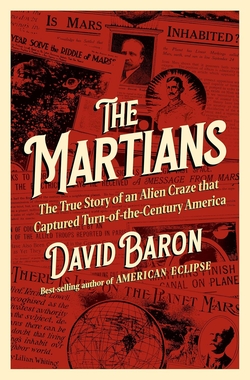Centauri Dreams
Imagining and Planning Interstellar Exploration
Voice of the (SF) Master: Stanislaw Lem and the Philosophy of SETI
Milan M. ?irkovi?’s work has been frequently discussed on Centauri Dreams, as a glance in the archives will show. My own fascination with SETI and the implications of what has been called ‘the Fermi question’ led me early on to his papers, which explore the theoretical, cultural and philosophical space in which SETI proceeds. And there are few books in which I have put more annotations than his 2018 title The Great Silence: The Science and Philosophy of Fermi’s Paradox (Oxford University Press). Today Dr. ?irkovi? celebrates Stanislaw Lem, an author I first discovered way back in grad school and continue to admire today. A research professor at the Astronomical Observatory of Belgrade, (Serbia), ?irkovi? obtained his PhD at the Dept. of Physics, State University of New York in Stony Brook in 2000 with a thesis in astrophysical cosmology. He tells me his primary research interests are in the fields of astrobiology (habitable zones, habitability of galaxies, SETI studies), philosophy of science (futures studies, philosophy of cosmology), and risk analysis (global catastrophes, observation selection effects and the epistemology of risk). He co-edited the widely-cited anthology Global Catastrophic Risks (Oxford University Press, 2008) with Nick Bostrom, has published three research monographs and four popular science/general nonfiction books, and has authored about 200 research and professional papers.
by Milan ?irkovi?

This year we celebrate a centennial of the birth of a truly great author and thinker who is still, unfortunately, insufficiently well-known and read. Stanislaw Lem was born in 1921 in then Lwów, Poland (now Lviv, Ukraine). That was the year ?apek’s revolutionary drama R.U.R. premiered in Prague’s National Theatre and defined the word “robot”, Albert Einstein was awarded the Nobel Prize in physics for his work on the photoelectric effect in the course of which he effectively discovered photons, and one Adolf Hitler became the leader of a small far-right political party in Weimar Germany.
All three of these central-European developments have exerted a strong influence on Lem’s life and career. His studies of medicine, inspired by both his father’s distinguished medical career and his early-acquired mechanistic view of human beings, have been interrupted three times due to the chaos of WW2 and post-war changes. He narrowly escaped being executed by German authorities during the war for his resistance work. Finally, when he was on the verge of acquiring a diploma at the famous Jagiellonian University of Krakow, in 1949, he abandoned the pursuit in order to avoid the compulsory draft to which physicians were susceptible in the new communist Poland. He did some practical medical work in a maternity ward, but very quickly left medicine for good and became a full-time writer.

The apex of Lem’s creative career spans about three decades, from The Investigation published in 1958, to the publication of Fiasco and Peace on Earth in 1987. During that period, he published his greatest novels, in particular Solaris (1961), The Invincible (1966), His Master’s Voice (1968), and The Chain of Chance (1976), along with numerous short story anthologies, the most important being The Cyberiad (1965), as well as the Ijon Tichy and Pilot Pirx story cycles.
Image: Polish science fiction writer Stanislaw Lem. Credit: Wojciech Zemek.
Finally, several works in the Borgesian meta-genre of imaginary forewords, introductions, and book reviews, notably The Perfect Vacuum of 1971. This has been complemented by very extensive non-fiction writing, mainly in several fields of philosophy of science, futures studies, and literary criticism. The last two decades of Lem’s life were characterized by essayistic and publishing activity, as well as receiving innumerable prizes and awards, but no original fiction writing. Lem passed away peacefully on March 27, 2006, at the age of 84 in his home in Krakow.
Lem was obssessed by the theme of Contact: from his very first science-fiction novel, The Astronauts in 1951 (which he himself denounced as “childish”) to the last, great and deeply disturbing Fiasco, which is a kind of literary and philosophical testament. Nowhere, however, is his thought more in touch with the practical aspects of our SETI/search for technosignatures projects as in His Master’s Voice (originally published in 1968, that is only 8 years after the original Ozma Project! Translated into English by Michael Kandel only in 1983).

It is a brilliant work, perhaps the best novel ever written about SETI, but also a dense tract indeed. So, instead of many examples, I shall concentrate upon this one as a case study for the tremendous usefulness of reading Lem for anyone interested in astrobiology/SETI studies.
The study of the motives and ideas relevant for these fields would require a book-length treatment, as is obvious from the list of auxiliary topics Lem masterfully weaves into the narrative: from the ontological status of mathematical objects to the psyche of the Holocaust survivors, from preconditions for abiogenesis to the origin of the arrow of time. It is a challenging text in more than one sense; there is almost no dialogue and no manifest action beyond the recounting of a SETI project that not only failed but was never truly comprehended in the first place.
Image: A 1983 English edition of His Master’s Voice from Harcourt Brace Jovanovich, one of many editions available worldwide.
And this is a book whose plot should not be spoilt, since it is not as widely read as it should be half a century later. Without revealing too much, His Master’s Voice is set at a time when neutrino astrophysics is advanced enough to be able to detect possible modulations (imagined to have occurred near the end of the 20th century in the continued Cold War world). A neutrino signal repeating every 416 hours is discovered from a point in the sky within 1.5° of Alpha Canis Minoris. An eponymous top-secret project is then formed in order to decrypt the extraterrestrial signal, burdened by all the Cold-War paranoia and heavy-handed bureaucracy of the second half of the twentieth century. The project has its ups and downs, including some quite dramatic and literally threatening the survival of human civilization, but it is—obviously—mostly unsuccessful. The protagonist, a mathematical genius and cynic named Peter Hogarth, is neither a hero nor a villain; the SETI plot ends in anticlimactic uncertainty.
An intriguing consequence of Lem’s scenario is a realization that, while detectability generally increases with the progress of our astronomical detector technology, it does so very unevenly, in jumps or bursts. Although the powerful source of the “message” in the novel (presumably an alien beacon) had been present for a billion years or more, it became detectable only after a sophisticated neutrino-detecting hardware was developed. And even then, the detection of the signal happened serendipitously. Thus, in a rational approach to SETI—not often followed in practice, alas—the issue of detectability should be entirely decoupled from the issue of synchronization (the extent to which other intelligent species are contemporary to us).
Fermi’s paradox does not figure explicitly in His Master’s Voice (in contrast to many other of Lem’s works, especially his late and in my opinion equally magnificent Fiasco), and for an apparently obvious reason: “the starry letter” has always been here, or at least long enough on geological timescales. Detectability is, at least in part, a function of historical human development.
And there is a very real possibility, in the context of the plot, that “the letter” does not originate with intentional beings at all. The fulcrum of the book is reached when three radical hypotheses are presented to weary researchers, including the one attributing the signal to purely natural astrophysical processes! But even in this revisionist case, there are other problems, especially in light of the fact that the signal manifests “biophilic” properties: it helps complex biochemical reactions, and scientists in the novel speculate about whether it helped the abiogenesis on Earth. If it did so, the same necessarily occurred on many other planets in the Galaxy, so even if we abstract the mysterious Senders, it is natural to ask: where are our peers? This leads to more severe versions of Fermi’s paradox. In the same time, it makes us think about the various forms directed panspermia could, in fact, take when we reject our anthropocentric thinking.
There is another key lesson. While the discovery of even a single extraterrestrial artefact (and Lem’s neutrino message can surely be regarded as an artefact in the sense of the contemporary search for technosignatures), would be a great step forward, it would not, at least not immediately, resolve the problem. If one could conclude, as some of the protagonists of His Master’s Voice do, that there exist just two civilizations in the Galaxy, us and the mysterious Senders, that would still require explanation. Two is, in this particular context, sufficiently close if not equal to one.
And this shows, finally, the true gift of Lem’s thought to astrobiology and SETI studies: a capacity to go one step beyond in strangeness, to kick us sufficiently strongly out of the grooves of conventional thinking, to disturb us—and offend us, if necessary—and make us reject the comfortable and usual and mundane. In a general sense, all philosophy should do the same for us; that it usually does not is indeed discouraging and depressing. From time to time, however, a thinker passes with a bright torch illuminating the path and indicating how clueless we in fact are.
Lem was just such a figure. Reading him is indeed the highest form of celebration of reason and wisdom.

Radial Velocity: NEID Spectrograph Goes to Work
The NEID spectrograph has passed the Operational Readiness Review necessary for final acceptance and regular operations. Developed by NASA and the National Science Foundation’s NN-EXPLORE exoplanet science program, it has been put through a lengthy commissioning process in the five years since the radial velocity planet hunter design was selected. NEID is mounted on the WIYN 3.5m telescope at Kitt Peak National Observatory in Arizona, and we now have word that its scientific mission has begun.
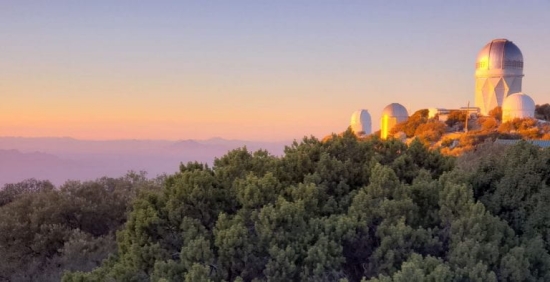
Image: Sunset over Kitt Peak National Observatory during NEID commissioning in January 2020. Credit: Paul Robertson.
As a radial velocity instrument, NEID is all about the tugs one or more planets exert on the host star, as measured radially — toward Earth, then away from it — during the planets’ orbits. The Doppler shift in the star’s light contains the information. That these are exquisitely tiny measurements should be obvious. Jupiter induces a 13 meter per second wobble on our star, but the Earth only manages to induce a wobble of 9 centimeters per second. NEID’s single measurement precision is already better than 25 centimeters per second, making it an excellent addition to the toolkit for finding new worlds.
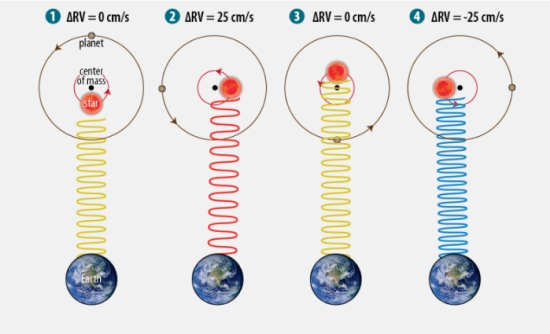
Image: A schematic of the Doppler effect: as the star wobbles under the gravitational influence of its planets, NEID measures the resulting wavelength shifts in its spectrum. Credit: NEID team.
It’s a tribute to the effort behind NEID that the team had to work through COVID-related shutdowns, in essence forcing them to start the commissioning process over, and as the NEID blog notes, for two winters in a row, they had to endure 12-hour nights of observing for up to a week at a time to get the job done. Nice work!
From December of 2020 to April of 2021, a series of experiments tested the reliability of the instrument, its precision and its limitations, making measurements of Doppler-stable stars to analyze the spectrometer’s limiting velocity measurement precision, as recounted in this blog entry by team members, from which this:
What we learned is that across a wide variety of targets, and in a wide variety of conditions, NEID offers radial velocity measurement precision that rivals the best facilities in the world. Our measurements of stable stars consistently show variability less than 1 meter per second. This on-sky stability reflects a combination of noise sources, including the instrument, statistical fluctuations (so-called “photon noise”), and the star’s inherent atmospheric variability. Thus, while it is hard to pin down an exact number, we are assured that NEID’s instrument-limited measurement precision is significantly better than 1 meter per second.
NEID seems on course to complement other high precision spectrographs like HARPS (High Accuracy Radial Velocity Planet Searcher), which is installed at the European Southern Observatory’s 3.6m telescope at La Silla Observatory in Chile, and its successor ESPRESSO (Echelle Spectrograph for Rocky Exoplanet- and Stable Spectroscopic Observations). How far can these instruments push into the centimeters-per-second range, so crucial for finding Earth-class planets?
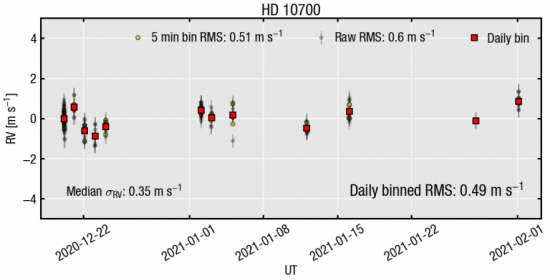
Image: NEID radial velocity measurements of the quiet star tau Ceti. Our on-sky measurements are stable to better than 50 centimeters per second, which indicates the instrument itself is even more stable. Credit: NEID Team.
The NEID team also plans to use a smaller solar telescope in combination with NEID during the day, its express purpose to gather data to produce better machine learning algorithms with which to separate the signal of planets from ‘starspots’ on the target star. These can confound detection efforts by mimicking a planet’s signature. The solar observations will be released publicly to help scientists address the problem, with data processing coordinated by the NASA Exoplanet Science Institute (NExScI) at Caltech/IPAC. The data will be made available through the NEID science archive.
For one direction NEID goes next, we can turn to Andrea Lin (Penn State), who designed and built the solar telescope. Lin explains her own choice of targets:
“The solar telescope was a fun project to work on. I look forward to using NEID for my doctoral dissertation research. One of my planned projects with NEID is to look for planets around K-dwarfs. These stars line up incredibly well with NEID’s capabilities, and the radial velocity method in general, so I’m hoping to discover some small—hopefully terrestrial!—planets around nearby K-stars.”
For further background on NEID, see the Centauri Dreams article New Entry in High Precision Spectroscopy.

Can Life Survive a Star’s Red Giant Phase?
If we ever find life on a planet orbiting a white dwarf star, it will be life that has emerged only after the red giant phase has passed and the white dwarf has emerged as a stellar relic. That’s the conclusion of a study being discussed today at the National Astronomy Meeting of Britain’s Royal Astronomical Society, which convened online due to COVID concerns. The work is also recently published in Monthly Notices of the Royal Astronomical Society.
At issue is the damage caused by powerful stellar winds that occur as a star makes the transition from red giant to white dwarf stage. This is the scenario that awaits our own Sun, which should swell to red giant status in roughly five billion years, eventually becoming a dense white dwarf about the size of the Earth. We’ve speculated in these pages about life surviving this phase of stellar evolution, but the study, in the hands of Dimitri Veras (Warwick University) concludes that this is all but impossible.
We know that the Earth is protected by a magnetosphere that thwarts atmospheric depletion by channeling harmful particles along magnetic field lines. You would think that a magnetosphere would ease this kind of erosion in the far future for those planets that have one (Mars, for example, does not) but the stellar winds of the evolving star will be far stronger than the Sun’s today. The authors modeled the winds from eleven different kinds of stars in a range of masses. They find this:
The plot shows that an exo-Jovian analogue would just reach the threshold for hosting a magnetopause at some point during giant branch evolution. However, much higher fields would be required to maintain any magnetopause throughout these giant branch phases. For terrestrial and potentially habitable planets, any protection previously afforded by the magnetosphere would effectively disappear. This lack of protection, compounded with orbital expansion and varying stellar luminosities, suggest that life would be challenged to survive throughout the giant branch phases of stellar evolution.
Could scenarios emerge in which moons around the gas giants maintain life under an ice crust? It’s hard to see how. Veras, working with Aline Vidotto (Trinity College, Dublin) points out that a habitable zone supporting liquid water would move from some 150 million kilometers from the Sun to up to 6 billion kilometers, pushing it beyond the orbit of Neptune. Planets can migrate during this phase, but the paper argues that the habitable zone moves outward faster than the planet, a likely fatal threat. Thus life around a white dwarf will need to start over.
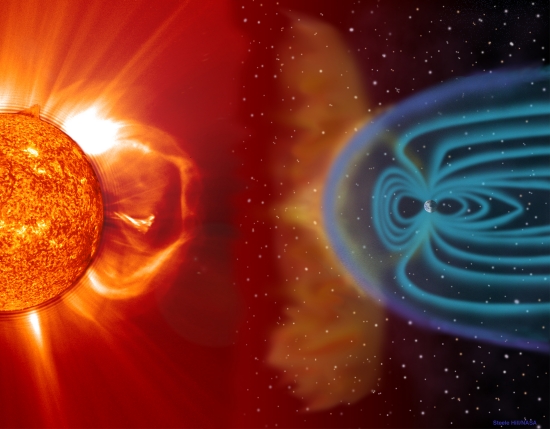
Image: An illustration of material being ejected from the Sun (left) interacting with the magnetosphere of the Earth (right). When the Sun evolves to become a red giant star, the Earth may be swallowed by our star’s atmosphere, and with a much more unstable solar wind, even the resilient and protective magnetospheres of the giant outer planets may be stripped away. MSFC / NASA. Licence type Attribution (CC BY 4.0).
Thus the movement of the habitable zone outward and the difficulty in maintaining a magnetosphere throughout this phase of stellar evolution make preserving habitability extremely unlikely. The authors’ model shows that the strong stellar wind combines with the expanding orbits of surviving planets to first shrink and then expand the magnetosphere of a planet over time. It would take a magnetic field 100 times stronger than Jupiter’s to maintain a stable magnetosphere all the way through the transition of red giant to white dwarf:
“We find that a planetary magnetosphere will always be quashed at some point during the giant branch phases, unless the planet’s magnetic field strength is at least two orders of magnitude higher than Jupiter’s current value.”
And afterwards? White dwarfs do not emit stellar winds, so that threat disappears. Any life we find around a white dwarf will doubtless have developed during the white dwarf phase. If such exists, we may be able to detect its biomarkers through future space missions — recall that white dwarfs are roughly the size of the Earth, and a transiting planet would produce profound transit depth and would seemingly be an ideal target for transmission spectroscopy, in which we analyze the components of a planetary atmosphere as starlight passes through it.
Most of the exoplanets we know about orbit main sequence stars, but about 100 are known to orbit red giants, and at least four have been found orbiting white dwarf stars. These worlds are survivors of stellar evolution and thus useful as benchmarks in tracing the lifetime of their systems. Two of the white dwarf planets, says Veras, are close to their star’s habitable zone, an indication of planet migration showing that an Earth-sized planet could exist in such an orbit. And he adds:
“These examples show that giant planets can approach very close to the habitable zone. The habitable zone for a white dwarf is very close to the star because they emit much less light than a Sun-like star. However, white dwarfs are also very steady stars as they have no winds. A planet that’s parked in the white dwarf habitable zone could remain there for billions of years, allowing time for life to develop provided that the conditions are suitable.”
The paper is Veras & Vidotto, “Planetary magnetosphere evolution around post-main-sequence stars,” Monthly Notices of the Royal Astronomical Society Vol. 506, Issue 2 (September 2021), pp. 1697-1703. Abstract / Preprint.

The Io Trigger: Radio Waves at Jupiter
Our recent discussion about Europa (Europa: Below the Impact Zone) has me thinking about those tempting Galilean moons and the problems they present for exploration. With a magnetic field 20,000 times stronger than Earth’s, Jupiter is a radiation generator. Worlds like Europa may well have a sanctuary for life beneath the ice, but exploring the surface will demand powerful radiation shielding for sensitive equipment, not to mention the problem of trying to protect a fragile human in that environment.
Radiation at Europa’s surface is about 5.4 Sv (540 rem), although to be sure it seems to vary, with the highest radiation areas being found near the equator, lessening toward the poles. In human terms, that’s 1800 times the average annual sea-level dose. Europa is clearly a place for robotic exploration rather than astronaut boots on the ground.
Jupiter offers up an environment where the solar wind, hurling electrically charged particles at ever-shifting velocities, interacts with the powerful magnetosphere, stretching it out almost 1000 kilometers away from the Sun. It’s essential that we learn more about the behavior of the magnetic fields generated by gas giants, and on that score new work out of Goddard Space Flight Center offers some insight. GSFC’s Yasmina Martos and team have been using the inner Galilean moon, Io, as a probe, studying what sets off one type of radio emissions known to emanate from Jupiter.
Io’s volcanoes have been observed since the first Voyager flyby, driven by internal heat as the moon experiences the gravitational pull not only of Jupiter but neighboring large moons. Gas and particles released by this activity are ionized and swiftly captured by Jupiter’s magnetic field, being accelerated along the field toward the Jovian poles.
Out of this we get decametric radio emissions (DAM) as electrons spiral in the magnetic field, waves that the Juno spacecraft’s Juno Waves Instrument has been detecting. Jupiter also produces radio waves at centimeter and decimeter wavelengths, caused by atmospheric phenomenon as well as activity in the magnetosphere apart from the Io interactions. The planet is, in fact, the noisiest radio emitter in the Solar System apart from the Sun. Homing in on the Io emissions, the GSFC work deploys a new magnetic field model with higher accuracy near the moon and targets the particular geometric configurations of planet and moon needed for Juno to detect the emissions.
Studying the radio emissions mediated by Io doesn’t help us cope with the radiation problem, but it does offer clues about this particular magnetosphere, a phenomenon we’ll come to know much better as future missions arrive. The researchers, reporting in the Journal of Geophysical Research: Planets, found that the decameter radio waves are controlled by not just the strength but the shape of Jupiter’s magnetic field. They emerge from a cone-like space thus formed, so that the spacecraft can only receive the radio signal when Jupiter’s rotation moves that cone across the instrument. The effect is similar to a lighthouse beacon sweeping out to sea.
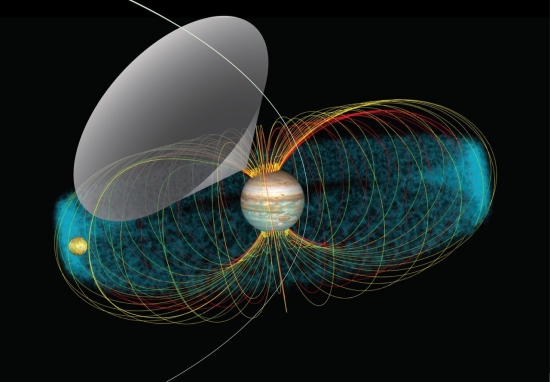
Image: The multicolored lines in this conceptual image represent the magnetic field lines that link Io’s orbit with Jupiter’s atmosphere. Radio waves emerge from the source and propagate along the walls of a hollow cone (gray area). Juno, its orbit represented by the white line crossing the cone, receives the signal when Jupiter’s rotation sweeps that cone over the spacecraft. Credit: NASA/GSFC/Jay Friedlander.
I can remember trying to pick up radio emissions from Jupiter with my first shortwave receiving set — they’ve been a known phenomenon since 1955, detectable from Earth at between 10 and 40 MHz. What we get thanks to the Juno observations is a clarification about why decametric radio waves originating in the northern hemisphere seem more abundant than those from the southern. The paper explains for the first time the particular geometric configurations producing these effects. The authors offer up a plain language summary to go along with the paper’s abstract, from which this:
Thanks to Juno, the geometry of the magnetic field has been better constrained as waves and magnetic field data have been continuously collected within the Jovian environment since July 2016. In this study, we estimate where the radio waves generate and the energy of the electrons that generate these waves, which is up to 23 times higher than previously proposed. We ultimately demonstrate that the geometry of Jupiter’s magnetic field is a primary controller for the higher observation likelihood of radio wave groups originating in the northern hemisphere relative to those originating in the southern hemisphere.
Video: The decametric radio emissions triggered by the interaction of Io with Jupiter’s magnetic field. The Waves instrument on Juno detects radio signals whenever Juno’s trajectory crosses into the beam which is a cone-shaped pattern. This beam pattern is similar to a flashlight that is only emitting a ring of light rather than a full beam. Juno scientists then translate the radio emission detected to a frequency within the audible range of the human ear. Credit: University of Iowa/SwRI/NASA.
What a fascinating place the Jovian system is. Learning the precise locations within the magnetosphere where the decametric emissions originate helps to pin down the needed magnetic field strength and electron density to fit the Juno data. “The radio emission is likely constant,” says Martos, “but Juno has to be in the right spot to listen.”
The paper is Martos et al, “Juno Reveals New Insights Into Io?Related Decameter Radio Emissions,” Journal of Geophysical Research: Planets (18 June 2020). Abstract.

Huge Comet Found to be Active
An interstellar freebie like ‘Oumuamua or 2I/Borisov is priceless. We don’t need to travel light years to see it because it comes to us. Although we’re expecting to find a lot more such objects as instruments like the Vera Rubin Observatory come online, right now only two are known to have passed through our system. But only slightly less inaccessible places like the Oort Cloud also bring gifts in the form of long-period comets, and I don’t want the advent of C/2014 UN271 Bernardinelli-Bernstein to go unnoticed in these pages, given its startling size and already detected activity.
Pedro Bernardinelli (University of Pennsylvania), who along with colleague Gary Bernstein discovered the comet, estimates its nucleus as being between 100 and 200 kilometers (62 and 125 miles) long. This dwarfs Hale-Bopp, and Colin Snodgrass (University of Edinburgh) is quoted in the New York Times as saying: “With a reasonable degree of certainty, it’s the biggest comet that we’ve ever seen.”
The discovery involved reprocessing data from the Dark Energy Survey, data that had been acquired via the 4-meter Blanco instrument at Cerro Tololo in Chile between 2013 and 2019. Bernardinelli and Bernstein announced the find in June of this year.
C/2014 UN271 was at roughly the distance of Neptune when first acquired in the data, although it is now about 20 AU out, or twice the distance of Saturn. While there was no statement about activity on the comet when the discovery was announced, astronomers at Las Cumbres Observatory quickly turned their network of telescopes on the object.
Las Cumbres offers a globally distributed network of telescopes with 24-hour robotic operation that is finely tuned to detect transients. Its instruments have now revealed that C/2014 UN271 is active, with the 1-meter LCO telescope at the South African Astronomical Observatory returning images that, in keeping with the international flavor of the observing effort, drew the attention of astronomers in New Zealand.
Thus Michele Bannister (New Zealand’s University of Canterbury):
“Since we’re a team based all around the world, it just happened that it was my afternoon, while the other folks were asleep. The first image had the comet obscured by a satellite streak and my heart sank. But then the others were clear enough and gosh: there it was, definitely a beautiful little fuzzy dot, not at all crisp like its neighbouring stars!”
Comet C/2014 UN271 was indeed active, that fuzzy dot indicating a coma. Volatile ices, likely carbon dioxide and carbon monoxide, were already reacting to the scant sunlight available. The coma was active even with the comet almost three billion kilometers from the Sun. No comet has ever been observed to be active this far from Sol.
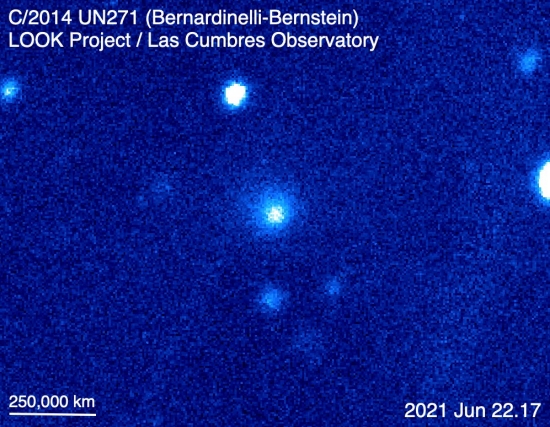
Image: Comet C/2014 UN271 (Bernardinelli-Bernstein), as seen in a synthetic color composite image made with the Las Cumbres Observatory 1-meter telescope at Sutherland, South Africa, on 22 June 2021. The diffuse cloud is the comet’s coma. Credit: LOOK/LCO.
This is one useful object, particularly since it was discovered early in its entry into the realm of the planets. It should offer astronomers over a decade of observing time. Perihelion is not expected until 2031, although when it comes, the comet will still be well beyond Saturn. Its orbit is now projected to take three million years to complete.
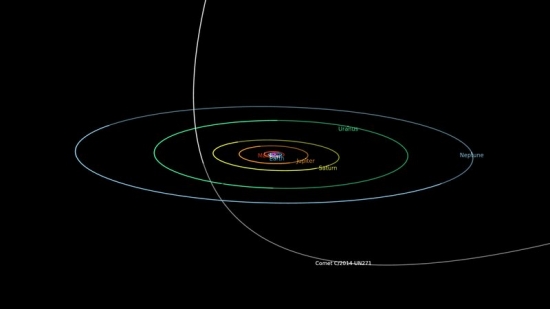
Image: An orbital diagram showing the path of Comet C/2014 UN271 (Bernardinelli-Bernstein) through the Solar System. The comets’ path is shown in gray when it is below the plane of the planets and in bold white when it is above the plane. Credit: NASA.
The discovery of activity on C/2014 UN271 draws attention to the LOOK Project now active at Las Cumbres. LOOK stands for LCO Outbursting Objects Key, an effort that investigates unexpected brightening of comets through burst activity and other aspects of comet evolution. Out of all this we should get a better understanding of comet outbursts, of which C/2014 UN271 is offering such a tantalizing sample.
These findings should also feed into future space missions like the European Space Agency’s Comet Interceptor, using data from this and other wide field surveys. Las Cumbres staff scientist Tim Lister explains:
“There are now a large number of surveys, such as the Zwicky Transient Facility and the upcoming Vera C. Rubin Observatory, that are monitoring parts of the sky every night. These surveys can provide alerts if one of the comets changes brightness suddenly and then we can trigger the robotic telescopes of LCO to get us more detailed data and a longer look at the changing comet while the survey moves onto other areas of the sky. The robotic telescopes and sophisticated software of LCO allow us to get images of a new event within 15 minutes of an alert. This lets us really study these outbursts as they evolve.”
That’s good news for the next interstellar object that wanders by as well. One of these days our growing network of instruments will be able to spot something like ‘Oumuamua in time for a spacecraft to pay it a visit.

Carbon Isotopes as Clues to a Young Planet’s Formation
300 light years from Earth in the constellation Musca, the gas giant TYC 8998-760-1 b, along with a companion planet, orbits an infant K-class star about 17 million years old. We’re probably looking at a brown dwarf here rather than a gas giant like Jupiter, for TYC 8998-760-1 b is about 14 times Jupiter’s mass, nudging into brown dwarf territory, and it appears to be roughly three times as large, unusual for brown dwarfs. The planet’s separation from its host star is pegged at 160 AU.
An inflated atmosphere due to processes still unknown? We don’t know, but both this and the companion planet have been directly imaged. Now TYC 8998-760-1 b resurfaces through work with the European Southern Observatory’s Very Large Telescope, as reported in the latest issue of Nature. Led by first author Yapeng Zhang (Leiden University, The Netherlands), the team of astronomers detected carbon isotopes in the object’s atmosphere, showing higher than expected carbon-13 content.
Here is the image, first released in 2020, of the TYC 8998-760-1 system, showing the two young planets. One of the co-authors of the Zhang paper, Alexander Bohn (also at Leiden), worked on the earlier imaging as well. The caption is the original one from ESO accompanying the image and does not describe the later work by Zhang’s team.
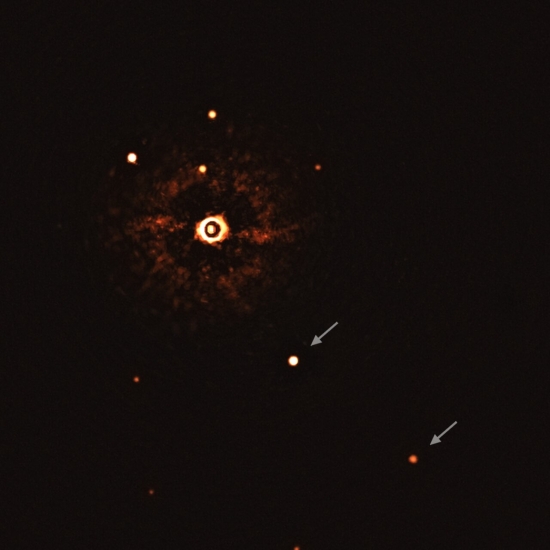
Image: This image, captured by the SPHERE instrument on ESO’s Very Large Telescope, shows the star TYC 8998-760-1 accompanied by two giant exoplanets, TYC 8998-760-1b and TYC 8998-760-1c. The two planets are visible as two bright dots in the centre (TYC 8998-760-1b) and bottom right (TYC 8998-760-1c) of the frame, noted by arrows. Other bright dots, which are background stars, are visible in the image as well. By taking different images at different times, the team were able to distinguish the planets from the background stars. The image was captured by blocking the light from the young, Sun-like star (top-left of centre) using a coronagraph, which allows for the fainter planets to be detected. The bright and dark rings we see on the star’s image are optical artefacts. Credit: ESO/Bohn et al.
Different forms of the same atom, isotopes vary in the number of neutrons housed in the nucleus, so that while carbon-12 has six neutrons to go along with its six protons, carbon-13 has seven neutrons and carbon-14 has eight. The distinctions are useful because while chemical properties remain largely the same, isotopes can be distinguished as they react to different conditions and are formed in different ways.
Zhang’s team drew on the distinction between carbon-13 and carbon-12 as marked by the way each absorbs radiation at slightly different colors, using ESO’s Spectrograph for Integral Field Observations in the Near Infrared (SINFONI), mounted on the Unit 3 instrument of the VLT. Expecting about one in 70 carbon atoms to be carbon-13, they found twice the number. The planet’s formation seems to be implicated, according to co-author Paul Mollière (Max Planck Institute for Astronomy, Heidelberg):
“The planet is more than one hundred and fifty times further away from its parent star than our Earth is from our Sun. At such a great distance, ices have possibly formed with more carbon-13, causing the higher fraction of this isotope in the planet’s atmosphere today.”
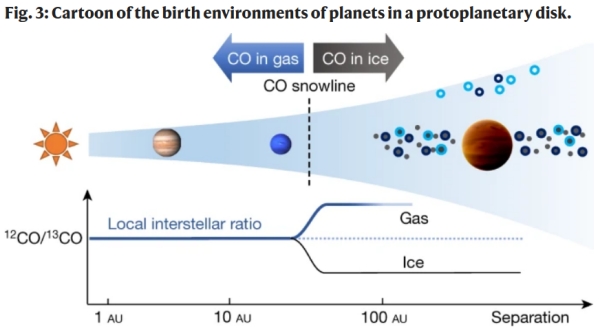
Image: This is Figure 3 from the paper. Caption: The two planets inside the CO snowline denote Jupiter and Neptune at their current locations, whereas TYC 8998 b is formed far outside this regime, where most carbon is expected to have been locked up in CO ice and formed the main reservoir of carbon in the planet. We postulate that this far outside the CO snowline, the ice was 13CO-rich or 13C-rich through carbon fractionation, resulting in the observed 13CO-rich atmosphere of the planet. A similar mechanism has been invoked to explain the trend in D/H within the Solar System. Future isotopologue measurements in exoplanet atmospheres can provide unique constraints on where, when and how planets are formed. Credit: Zhang et al.
The study of isotope abundance ratios has proven significant in studying not only interstellar chemistry and star formation but also the evolution of the Solar System. While its uses in analyzing exoplanet atmospheres are in their infancy, the hope is that future work on a range of exoplanets will offer clues to their formation.
The paper is Zhang et al., “The 13CO-rich atmosphere of a young accreting super-Jupiter,” Nature 595 (14 July 2021), 370-372. Abstract.

